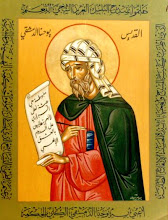To follow the Byzantine Daily Office (the Divine Praises, the Liturgy of the Hours), one must understand the Tones of Byzantine Worship and their basic impact on the celebration of a given service. Byzantine Worship, like classical Catholic worship in the West, utilizes a system of chant. In the West, this heritage comes down to us as Gregorian Chant. In the East, Churches of the Byzantine Tradition employ Byzantine Chant.
There are similarities between the two systems. Both employ eight different tonal frameworks which are applied to the liturgical text to be chanted. Typical patterns and melodies lend both variety and coherence to a given "tone." Certain subjects and circumstances are often associated with a given tone, whose tonal and melodic characteristics are said to make the tone in question more suitable.
There is a complete set of hymns for each service of the day for a full weekly cycle in each of the eight tones, beginning with the celebration of Great Vespers on Saturday evening. Thus there is an eight-week cycle that forms the backbone of Byzantine hymnody. The collection of these hymns is called, rightly enough, the Ochtoechos (literally, Eight Tones).
The cycle begins every year on the Sunday after All Saints Day, which is celebrated on the Sunday after Pentecost in the Byzantine Tradition. The cycle continues from week to week repeating itself throughout the year.
The Ochtoechos lends tonal continuity to the Divine Services within a given week and a flow of continuity from one week to the next throughout the year. It is essential to know the tone of the week for the celebration of the Liturgy and Divine Office services.
However, knowing the tone of the week is not the only thing needed to accurately celebrate in the Byzantine Tradition. Another factor influences and alters the selections for a given celebration. The Eothinon Gospel reading on Sunday morning during Orthros must be identified.
The word Eothinon (plural, eothina) comes from the Greek word indicating dawn, the traditional moment during Orthros when one of eleven passages from the Gospels recounting the Resurrection is read.
Associated with the Eothinon Gospel are the Exapostilarion and the Doxastikon. The Exapostilarion relates to the theme of being sent out that these hymns feature. The Doxastikon is a hymn praising God for the Resurrection and sung after the Glory to the Father… after the chanting of the Praises. The Eothina Gospels, and their associated hymns, are numbered simply one through eleven.
Knowing the number of the Eothinon for a given week is important for two reasons: firstly, because Sunday Orthros requires that the appropriate Eothinon Gospel be read along with its proper Exapostilarion and Doxastikon; and secondly a tone is assigned to each Eothinon, (and its Exapostilarion and Doxastikon). This tone also determines in which tone the Great Doxology (near the end of Orthros) is to be chanted.
This means that while the particular Sunday Orthros might be in Tone Two, the Eothinon may be in Tone Eight. Thus there will be noticeable tonal shifts in the chanting due to the different tones.
To summarize: In keeping the Divine Praises according to the Byzantine Tradition, the Tone of the Week determines which standard hymns are chosen from the Ochtoechos for that particular celebration on that day. Reference to the Eothinon influences the chosen Eothinon Gospel and its related Exapostilarion and Doxastikon, as well as the determining the tone used for the chanting of the Great Doxology.
Subscribe to:
Post Comments (Atom)


No comments:
Post a Comment